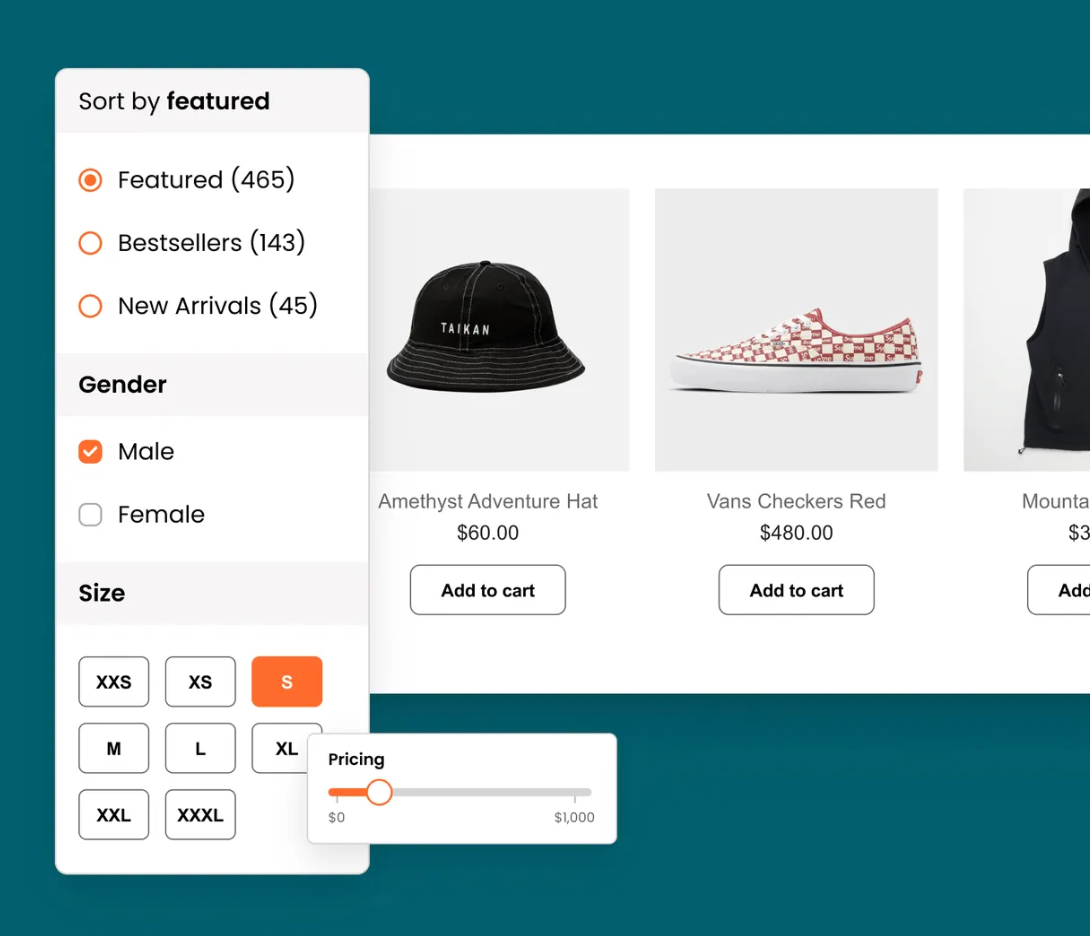7 Best Ecommerce Site Search Practices With Examples
In this blog , we will discover the power of personalized search in ecommerce online shop with our comprehensive guide to the 7 best practices. Whether you're a experienced ecommerce pro or just starting out, you'll find valuable insights to enhance your site's search functionality.

Have you ever felt frustrated when searching for products in an online store? You know what you want, but the search results seem to completely miss the mark. It's a common problem in ecommerce, and it's costing businesses sales opportunities. Without effective personalized search results, your customers may leave your site without making a purchase. This not only affects your sales but also damages your brand reputation.
But don't worry! In this blog post, we will share the 7 best ecommerce personalized search practices with examples to help you improve your customers' search experience. By the end of this article, you'll have actionable insights to implement and transform your ecommerce site into a conversion powerhouse.
What is a good ecommerce site search solution?
| Solutions | Details |
|---|---|
| Intelligent search algorithms | Natural language processing (NLP): Understands user intent, even with complex queries |
| Semantic search: grasps the meaning behind search terms, not just exact matches | |
| Machine learning: Improves results over time based on user behavior | |
| Error tolerance | Typo correction: Automatically fixes misspellings |
| Phonetic matching: Finds results for similarly sounding words | |
| Autocomplete: Suggests queries as users type, reducing errors | |
| Relevance ranking | Customizable relevance rules: Prioritize results based on business goals |
| Personalization: Tailors results to individual user preferences and history | |
| Contextual ranking: Considers factors like seasonality and current trends | |
| Faceted search and filtering | Dynamic facets: Allows users to narrow down results by attributes like size, color, or price |
| Multi-select facets: Enables selecting multiple options within a category | |
| Clear visual presentation: Makes it easy for users to understand and apply filters | |
| Product recommendations | Related products: Suggests items based on the current search or viewed product |
| Cross-selling: Recommends complementary items | |
| Upselling: Presents higher-value alternatives | |
| Analytics and reporting | Search insights: Provides data on popular searches, zero-result queries, and search patterns |
| A/B Testing: Allows experimenting with different search layouts and algorithms | |
| Conversion tracking: Measures the impact of search on sales | |
| Merchandising capabilities | Boosting and burying: Allows manual adjustments to search rankings |
| Promotional banners: Displays relevant offers within search results | |
| Visual customization: Matches the search interface to your brand aesthetic |
An effective ecommerce site search solution is not merely a means of locating products; it is also a tool for creating an intuitive and enjoyable shopping experience. By incorporating these features, you are not only assisting customers in finding what they are seeking but also guiding them towards discoveries they may not have known they desired.
When selecting a site search solution, it is essential to consider your specific requirements. Are you a small boutique or a large marketplace? Do you have a niche audience or a broad customer base? The ideal solution will grow with your business and adapt to your specific needs.
Investing in a high-quality e-commerce site search solution is an investment in your customers' experience. It's about making their journey from search to purchase as smooth and enjoyable as possible.
What is ecommerce personalized search and why it is important?
Ecommerce personalized search is an innovative approach that transforms traditional ecommerce search into a customized, user-centric experience. Unlike a standard ecommerce search engine that simply matches keywords and ranks based on keyword relevance and popularity, personalized search incorporates additional factors like user location, behaviors, and even current trends or seasonality. This way of search not only makes shopping more enjoyable but also increases the efficiency that user will find exactly what you need.
You may be confused about 'how does it work?', ecommerce personalized search uses sophisticated algorithms that analyze a wealth of data about each user's purchases, browsing history, wishlist items, and even real-time behavior on the site. It then combines this personal data with broader trends and product information to create a unique search experience for each shopper.
Why ecommerce personalized search is important? Imagine walking into a physical store and seeing the shelves rearranged based on what you're most likely to buy - that's the power of personalized search in the digital realm. It dramatically improves the user experience by reducing search time, increasing the likelihood of finding the products you want, and ultimately increasing conversion rates. For online retailers, this means happier customers, increased sales, and a competitive edge in the crowded e-commerce landscape.
7 Best ecommerce personalized search practices with examples
When it comes to ecommerce personalized search, there are so many practices that can transform your online store's search experience. Here are seven of the best with examples:
1. Intelligent Search Popups
- Search Suggestion: Offering real-time suggestions as users type can significantly enhance their search experience.
- Search Correction: Automatically correcting typos or misspellings ensures users find what they're looking for.
- Collection Page Search: Allowing users to search within specific collections or categories can streamline their shopping experience.
- Content Search (Blog, FAQ): Including content search capabilities for blogs and FAQs can provide valuable information and enhance user engagement.
- Stemming: Implementing stemming to recognize variations of words can improve search accuracy.
Example: Imagine a customer searching for "running shoe" on an ecommerce site. The search popup suggests "running shoes," corrects the typo "running shoe," and offers collections like "Men’s Running Shoes" and blog articles on "Best Running Shoes of 2024."

2. Advanced Search Result Pages
- Filter: Providing filters on the search result page allows users to narrow down their options based on specific criteria
- Sort Type: Offering various sorting options, such as price, popularity, and newest arrivals, can help users organize search results according to their preferences.
Example: If a user searches for "laptops," they can filter results by brand, price range, and specifications like RAM size. They can also sort by relevance, highest-rated, or lowest price first.

3. Smart Merchandising
- Pin (Keywords Level): Pinning specific products to appear at the top of search results for certain keywords can drive sales of high-priority items.
- Exclude (Words, Products, Collections): Excluding certain words, products, or collections from search results can prevent irrelevant items from appearing.
- Promote (Search Influence/Weight): Promoting certain products by influencing their search weight can highlight best-sellers or high-margin items.
- Synonym: Using synonyms in search algorithms ensures that users find relevant products even if they use different terms.
- Trigger: Setting up triggers for specific search terms can display promotional banners or special offers.
Example: For the keyword "summer dress," an ecommerce site might pin the latest summer collection at the top, exclude winter dresses, promote high-margin products, and recognize synonyms like "sundress."
4. Multi-Modal Search
- Incorporating visual and voice search options can cater to different user preferences and enhance the overall search experience.
Example: This feature allows users to upload a photo of an outfit or item they like, and the search engine finds similar products in their catalog. This visual search capability makes it easier for shoppers to find products that match their style preferences.

5. A/B Testing and Analytics Dashboard
- Implementing A/B testing for search features and providing a comprehensive analytics dashboard helps optimize the search experience over time.
Example: You can use A/B testing to continually refine your search algorithms and user interface. It also provides you with detailed analytics on how your products perform in search results, allowing for data-driven improvements.
6. Customizable Design
- Offering a customizable search interface that aligns with the brand's aesthetic can improve user engagement and trust.
Example: An ecommerce online shop features a minimalist search design that matches its overall brand aesthetic. The search bar expands smoothly when clicked, providing a seamless and on-brand user experience
7. Flexible Implementation
- API: Using APIs for search implementation allows for seamless integration with other systems.
- Admin Editor: An admin editor enables easy customization and management of search settings.
Example: A small ecommerce business might use an admin editor to easily configure search settings without extensive technical knowledge, while a larger enterprise might integrate advanced search capabilities through a robust API.
Implementing these practices: where to start?
Ready to revolutionize your on-site search, but not sure where to start? Don't worry! The key to implementing these practices is to start with the basics and build from there.
- Focus on improving your core ecommerce search functionality.
- Address search suggestions and autocorrection.
- Optimize your search results page with clear filters and sorting options.
- Experiment with merchandising techniques such as pinning and synonyms. Remember.
These steps may seem difficult to implement on your own. Many ecommerce systems, like AfterShip Personalization, offer built-in tools or integrations to enhance your search capabilities.You can reading our page 'Top 10 Ecommerce Recommendation Systems' to choose the best one!
Conclusion
As we've explored, implementing a great search experience is critical to successful ecommerce business. A personalized search engine can dramatically improve customer satisfaction, boost conversions, and set your store apart from the competition. Do you want to realize these practices all in one Conveniently? Try AfterShip Personalization which can help you provide the kind of intuitive, personalized search experience that keeps customers coming back!




Comments ()